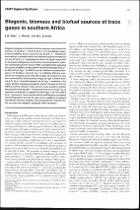JavaScript is disabled for your browser. Some features of this site may not work without it.
- ResearchSpace
- →
- Research Publications/Outputs
- →
- Journal Articles
- →
- View Item
| dc.contributor.author |
Otter, LB

|
|
| dc.contributor.author |
Marufu, L

|
|
| dc.contributor.author |
Scholes, MC

|
|
| dc.date.accessioned | 2007-06-12T07:51:30Z | |
| dc.date.available | 2007-06-12T07:51:30Z | |
| dc.date.issued | 2001-03 | |
| dc.identifier.citation | Otter, LB, Marufu, L and Scholes, MC. 2001. Biogenic, biomass and biofuel sources of trace gases in southern Africa. South African Journal of Science, vol. 97, 04 March, pp 131-138 | en |
| dc.identifier.issn | 0038-2353 | |
| dc.identifier.uri | http://hdl.handle.net/10204/587 | |
| dc.description | Copyright: 2001 Bureau Scientific Publications | en |
| dc.description.abstract | Biogenic processes in southern African savannas are estimated to produce 1.0 Tg NO yr(-1), 44.2-87.8 Tg C yr(-1) as non-methane hydrocarbons (NMHCs) and to consume 0.23 Tg CH4 yr(-1). Floodplains and wetlands in southern Africa are estimated to generate between 0.2 and 10 Tg CH4 yr(-1) (excluding the effects of aquatic vegetation on emissions). Biogenic emissions from the subcontinent's savannas constituted twice the amount of NO, and significantly exceeded the amount of NMHCs produced from biomass burning (0.55 Tg yr(-1) for NO and 0.49 Tg yr(-1) as NMHCs) as well as that of industrial emissions (1.75 Tg NO yr(-1) and 0.61 Tg y(-1) as NMHCs). Methane emissions from floodplains and wetlands could be more important than the combined effect of savanna burning (0.38 Tg yr(-1)), biofuel burning (0.24 Tg yr(-1)) and anthropogenic (2.59 Tg yr(-1)) emissions in the region. Biofuel combustion produces similar amounts of CO and NMHCs, half the amount of CO2 and CH4, and a quarter of the NO. That savanna burning does. Industrial emissions are shown to be important contributors to regional CO (5.6 Tg yr(-1)) and CO2 (360.0 Tg yr(-1)) emissions. These results indicate that biogenic, pyrogenic and anthropogenic sources all need to be considered in regional and national emission budgets, and as bases for the recommendation of policy and mitigation strategies within the region. | en |
| dc.language.iso | en | en |
| dc.publisher | Bureau Scientific Publications | en |
| dc.subject | Biomass burning | en |
| dc.subject | Biogenic processes | en |
| dc.subject | Biofuel burning | en |
| dc.subject | Trace gases | en |
| dc.subject | South Africa | en |
| dc.title | Biogenic, biomass and biofuel sources of trace gases in southern Africa | en |
| dc.type | Article | en |
| dc.identifier.apacitation | Otter, L., Marufu, L., & Scholes, M. (2001). Biogenic, biomass and biofuel sources of trace gases in southern Africa. http://hdl.handle.net/10204/587 | en_ZA |
| dc.identifier.chicagocitation | Otter, LB, L Marufu, and MC Scholes "Biogenic, biomass and biofuel sources of trace gases in southern Africa." (2001) http://hdl.handle.net/10204/587 | en_ZA |
| dc.identifier.vancouvercitation | Otter L, Marufu L, Scholes M. Biogenic, biomass and biofuel sources of trace gases in southern Africa. 2001; http://hdl.handle.net/10204/587. | en_ZA |
| dc.identifier.ris | TY - Article AU - Otter, LB AU - Marufu, L AU - Scholes, MC AB - Biogenic processes in southern African savannas are estimated to produce 1.0 Tg NO yr(-1), 44.2-87.8 Tg C yr(-1) as non-methane hydrocarbons (NMHCs) and to consume 0.23 Tg CH4 yr(-1). Floodplains and wetlands in southern Africa are estimated to generate between 0.2 and 10 Tg CH4 yr(-1) (excluding the effects of aquatic vegetation on emissions). Biogenic emissions from the subcontinent's savannas constituted twice the amount of NO, and significantly exceeded the amount of NMHCs produced from biomass burning (0.55 Tg yr(-1) for NO and 0.49 Tg yr(-1) as NMHCs) as well as that of industrial emissions (1.75 Tg NO yr(-1) and 0.61 Tg y(-1) as NMHCs). Methane emissions from floodplains and wetlands could be more important than the combined effect of savanna burning (0.38 Tg yr(-1)), biofuel burning (0.24 Tg yr(-1)) and anthropogenic (2.59 Tg yr(-1)) emissions in the region. Biofuel combustion produces similar amounts of CO and NMHCs, half the amount of CO2 and CH4, and a quarter of the NO. That savanna burning does. Industrial emissions are shown to be important contributors to regional CO (5.6 Tg yr(-1)) and CO2 (360.0 Tg yr(-1)) emissions. These results indicate that biogenic, pyrogenic and anthropogenic sources all need to be considered in regional and national emission budgets, and as bases for the recommendation of policy and mitigation strategies within the region. DA - 2001-03 DB - ResearchSpace DP - CSIR KW - Biomass burning KW - Biogenic processes KW - Biofuel burning KW - Trace gases KW - South Africa LK - https://researchspace.csir.co.za PY - 2001 SM - 0038-2353 T1 - Biogenic, biomass and biofuel sources of trace gases in southern Africa TI - Biogenic, biomass and biofuel sources of trace gases in southern Africa UR - http://hdl.handle.net/10204/587 ER - | en_ZA |






